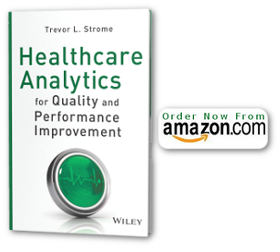This posting is an extracted and abridged selection from my book “Healthcare Analytics for Quality and Performance Improvement”, published by John Wiley & Sons Inc., and available at Amazon.com in hardcover and e-reader formats.
Healthcare data volumes continue to increase
Healthcare organizations have more data available to them than ever before. Purely “raw” data is rarely useful, however, for healthcare quality and performance improvement. To begin with, there is now often too much data generated through all the activities and systems within healthcare to use effectively. Indicators provide convenient performance snapshots of processes, financial measures, and outcomes critical to the quality and performance goals of the healthcare organization.
More reports are not necessarily the answer
As a result of the increasing volumes of available data and the abundance of analysis tools, more reports, dashboards, and other information requests are being generated than ever before. Even though healthcare organizations are experiencing a proliferation of dashboards and other information tools, many are still struggling to improve their quality, performance, and competitiveness. It is clear, then, that having data, producing more reports, and developing more dashboards is not the answer.
Summarizing healthcare data
Rather than simply collecting more data, healthcare leaders need information grouped and summarized in logical ways that let them know how their organization is performing. The usual starting point is to define measures, metrics, and indicators that are representative parameters for examining the performance of the organization.
-
Measure – The term “measure” (when used as a noun) in healthcare typically refers to a quantitative value representing some aspect of patient care, and may (or may not) be linked to specific performance and quality improvement initiatives.
-
Metric – A “metric” is some aspect of healthcare quality or performance to which a quantitative value is attributed for purposes of monitoring and evaluation. I consider metrics to be measures with more focus and purpose. Metrics typically specify a given point of time or a time period. Metrics can be situational (for example, they may be relevant only for a special purpose or project), but can also measure performance longitudinally, as long as the metric is relevant to some component of quality or performance that the healthcare organization needs to monitor.
-
Indicator – A metric without context may be insufficient for making decisions—it is merely “a number,” and having too many metrics may actually contribute to information overload and impede decision making. Indictors, then, are metrics that are more useful for driving business decisions, because indicators have context assigned to them. Some of the most important pieces of contextual information that separates an indicator from a metric is having an acceptable range and target assigned to the indicator, which is necessary to
-
identify whether current performance is “good” or “bad,”
-
determine how far away performance is from reaching its performance target, and
-
tell whether performance is trending toward meeting the target (or staying within target range) or if it is trending away from the target (or trending toward becoming out of the target range).
-
In conclusion
To keep focus on the measures that matter, performance dashboards are typically populated with indicators. Indicators are preferable on dashboards and performance reports because they relate to a particular process or other component of the healthcare business. When using indicators with an appropriate visualization approach, not only can trends be spotted, but the associated targets highlight whether performance is acceptable or not, and improving or getting worse.
Growing volumes of data now typical in healthcare are more likely to lead to information overload than insight unless data can be appropriately grouped, summarized, and presented in ways that enable decision-makers can understand and act on. Healthcare performance indicators are one very effective approach to generating the insight required by healthcare decision-makers to improve the quality, safety, and efficiency of healthcare.
Next in the series…
“Developing effective performance metrics”, the second article on the series of healthcare performance indicators, will be posted the week of November 11. Follow me on Twitter, sign up for email updates, and subscribe to the RSS feed to be notified when the next article is available.

{ 0 comments… add one now }